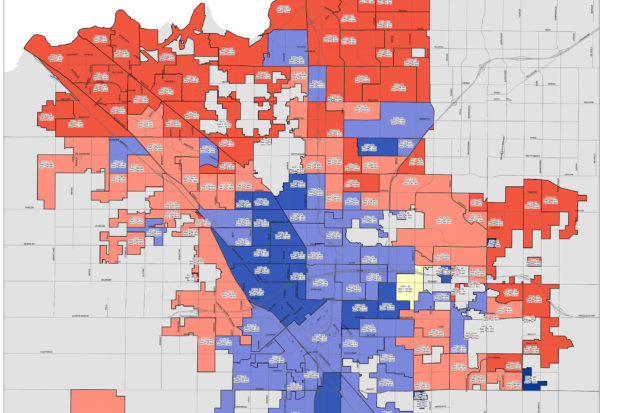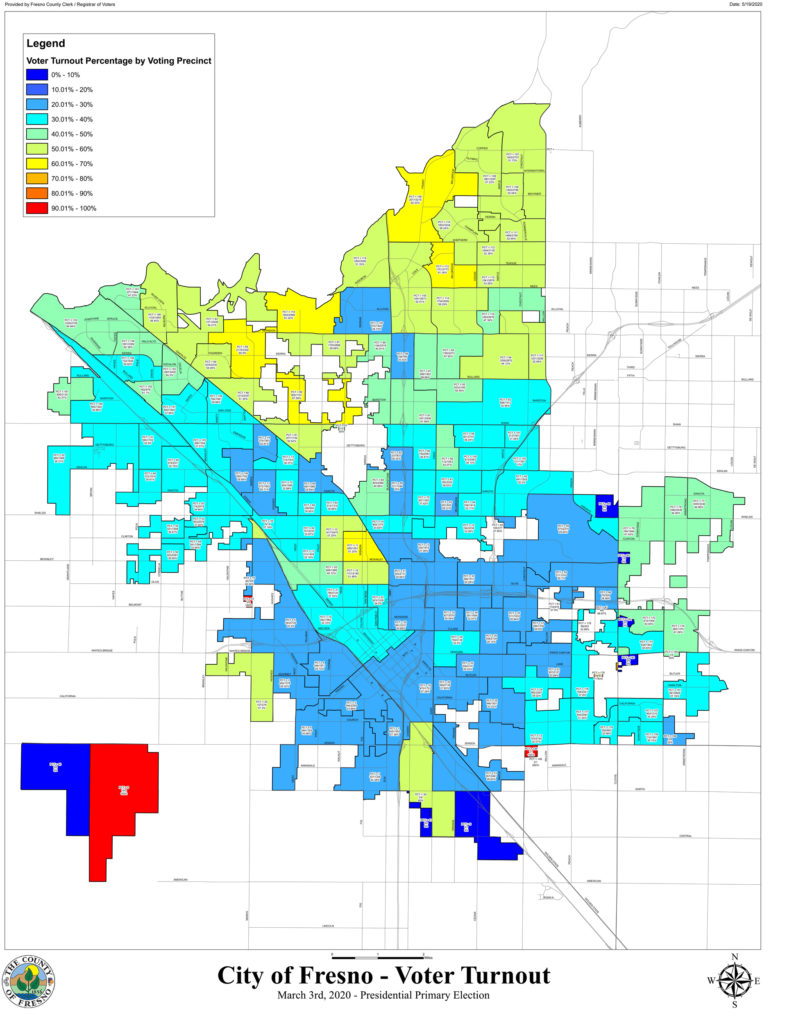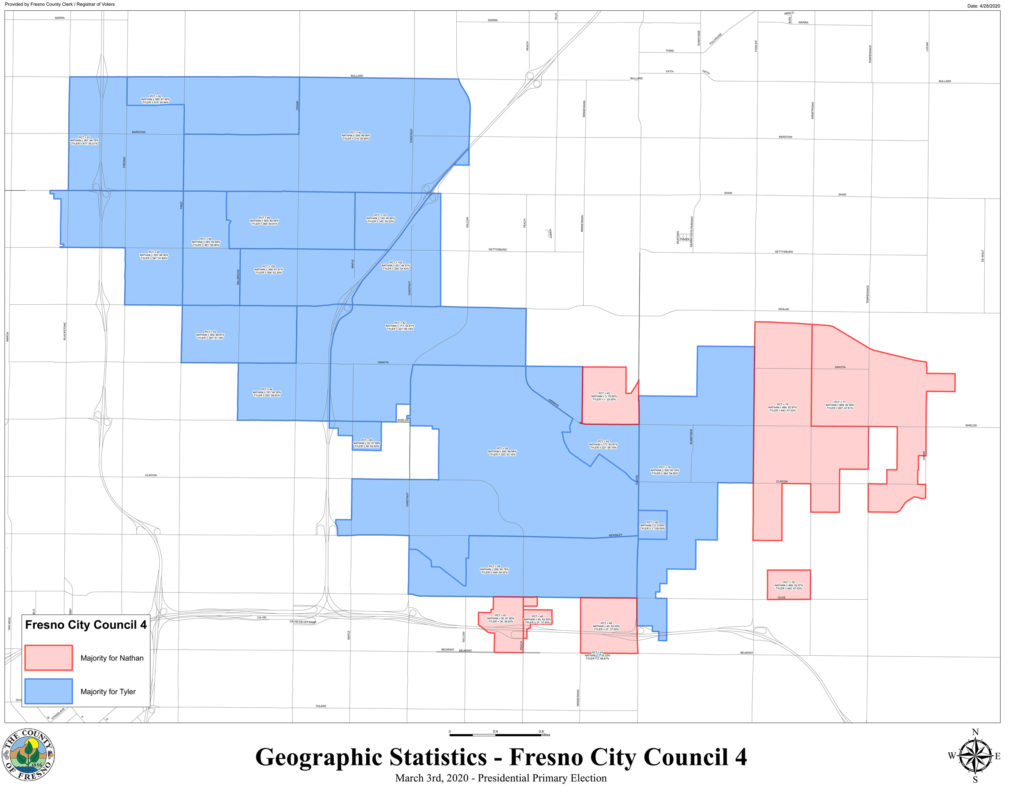
By Mike Rhodes
Progressives in Fresno did not want to see Jerry Dyer elected mayor. They see Dyer as a mini-Trump and did everything they could to stop him from being elected. Dyer’s nefarious misdeeds were exposed, money was raised for Andrew Janz (his most viable opponent), Independent Expenditure committees spent large amounts of money to defeat him and yet—Dyer won.
Not only was Dyer elected mayor, but he also significantly won over parts of the city that have traditionally voted for the more progressive candidate or ballot measure. How did that happen? To answer that question, several progressive activists, politicians and people working on pro-Janz/anti-Dyer campaigns were asked what went wrong.
First, a reality check. If Dyer, according to the Fresno County Registrar’s Office, got 50,914 votes and there are about 403,000 residents 18 and older in the city of Fresno, then Dyer received 12.6% of the vote. Hardly a mandate.
Over the years, this newspaper has used maps to illustrate the Tale of Two Cities, showing how precincts in north Fresno consistently vote for conservative candidates. Voting turnout in those precincts is extremely high. In the southern half of the city, turnout is extremely low. Sometimes only 20%–30% of eligible voters turn out, but they consistently vote for the more progressive candidate.
The troubling thing about the March 3 mayoral election is that the number of conservative precincts in north Fresno has expanded and is penetrating further south. Is this a blip in the electoral system or a trend? Inquiring minds want to know.
Simone Cranston-Rhodes, president of the Central Valley Progressive PAC (CVPPAC), sees this as a dangerous trend. She said that “the CVPPAC has spent a long time educating Fresno residents that the majority of the precincts in the city vote blue. Unfortunately, with the 2020 mayor’s race the distinction between north and south Fresno voting patterns has become blurred and the line of conservative voting creeped farther south than I ever thought it would go.
“It is up to the CVPPAC and other Democratic and progressive groups to figure out why this is and how we can change it. If not, then we are conceding our city to the Republicans.”
The CVPPAC carried out a significant Independent Expenditure (IE) campaign targeting 18–35 year olds in southeast and southwest Fresno, in hopes of electing Janz.
Sergio Cortes was the CVPPAC IE social media coordinator and has this analysis for what is happening in Fresno. He said that “Fresno has a long history of systemically marginalizing immigrants and people of color. This history has largely favored Fresno’s White conservative residents. Our mayoral elections have reflected that.
“As a community, we can’t simply just focus on getting people to vote. We need to dismantle systems and structures that are barriers that prevent people from voting here in Fresno. I do believe we are making progress, but there is still more work to be done.”
Cortes also is the founder of uSpark, an independent fact-based media project covering Central Valley politics for Millennial and Gen Z residents.
Jason Carns, a Democratic political consultant, has a different perspective about how to view the data. He said that “Jerry Dyer was the best candidate the Republicans had to offer. It is why they replaced Lee Brand with Dyer.
“The pro-Dyer forces spent almost three times as much money, and Dyer being retired had much more time than working expectant father Andrew Janz. That Dyer was only able to get 52% of the vote with such a strong moderate campaign in a primary race shows the continued Republican decline in Fresno.”
Veva Islas, founder and executive director of Cultiva La Salud, pointed out that “Janz was held back by a boss that supported his opponent. It was very unfair.”
Islas continues, “Defeat is demoralizing the progressive movement in Fresno. When people lose hope in things changing, they give up.
“Beyond having a true progressive and inspiring leader, the progressive movement in Fresno needs wins. Those wins should be successful campaigns that address the deeply entrenched inequities and injustices our communities continue to endure; in the end this is what is most motivating to progressives.”
Looking at the map of the outcome of the mayoral race last March, Daren Miller, Ed.D., educational advocate and community activist, said that “the results displayed in the map are curious. The newest areas of Fresno, where younger home-owning families are located, voted for Dyer (west of Highway 99 and far southeast Fresno). Also, the 93722 corridor along Highway 99, which houses the highest number of African American registered voters, also was mostly carried by Dyer. We, progressives, have a lot of work to do.”
Dee Barnes, worked with Rising Together, No on Dyer for Mayor 2020, the largest IE campaign involved with defeating Dyer, believes that Dyer won “because everyone knew his name and was familiar with his face. Even after he retired in October, he continued to receive free press coverage and took advantage of every photo op available.
“The ability to raise enough money to air numerous television ads and send dozens of mailers combined with low voter turnout and very long lines at voting centers on election day, made it possible for him to receive more than 50% of the vote in the primary.”

The long lines at voting centers were not the only obstacle voters faced. There were also more than 2,000 people in the Fresno County Jail during the election who could not get out to vote. Two-thirds of the people in jail have not been convicted of a crime and are just awaiting trial; their votes might have changed the outcome of the election. Voter suppression in this county manifests itself in many ways that go unnoticed by most people.
Juan Arambula, a major contributor to the Rising Together IE campaign to defeat Dyer and a former Assembly Member, said that “with a strong and well-known candidate, who was constantly on TV for over 20 years, and a candidate with his hands tied behind his back, the outcome was not surprising.”
Climate change activist Kevin Hall said that “the maps don’t surprise me. They reflect our need for better candidates, campaigns’ strengths and weaknesses, election dynamics and the value of incumbency. Dyer must be considered to have run as an incumbent.
Obama 2008 was an unprecedented phenomenon for Democratic turnout, and 2012 was closer to normal but still high. Henry R. Perea did well in 2016 because he was a sitting [Fresno] County supervisor and past two-term [Fresno] City Council member, but he and Janz both lost because their campaigns were outspent and out-messaged.
“Likewise, it was truly stunning to see Henry T. Perea lose in 2008 when Obama was top of the ticket, but his opponent, Ashley Swearengin, had the backing of Juan Arambula, Elliott Balch and other Blue Dog Democrats, so chalk that up to division in the ranks and Perea’s weaknesses as a candidate.”
Past CVPPAC president Howard Watkins said, “For most voters, Jerry Dyer has a positive reputation. What is sad is that Democrats did not turn out, even when all they had to do was mark their ballot, put it in the postage-paid envelope, sign and date the envelope, and drop it in the mailbox.”
Former Fresno County Supervisor Henry R. Perea, who ran for mayor four years ago, said, “If you look at the vote spread in many of these precincts, it was more a function of a well-funded and popular former police chief coupled with a low voter turnout. The progressives are there; they just have to come out and vote.”
Longtime local political activist Gloria Hernandez said, “I think [Janz] needed more exposure. I didn’t like his answer when I asked if he would allow the Independent Police Auditor more powers. He responded ‘no’ and [said] that he believed the DA (District Attorney) should be doing the job.
“But I still voted for him when he said the first thing he would do is approve the Peace Academy and raise the money by having a yard sale and getting rid of the military tanks.”
Annalisa Perea, who is vice president of the State Center Community College District Board of Trustees, said, “From my perspective, it’s critical we coordinate our campaigns as much as possible where there’s overlap districts. That’s what we did in 2018 and that’s what we’ll be doing for the upcoming 2022 races.
“When campaigns are able to consolidate resources such as canvassers, we’re able to be more efficient and we’re able to spread our resources further to be most effective.
“Identifying candidates early is crucial to ensure we’re able to build a coalition of support around the candidate right out the gate. Whether it’s fund-raising or volunteering at a phone bank, once an ideal candidate has been identified, we need to support that candidate in any and every way we can, as early as we can. This will help set the tone and energy for the rest of the campaign.”
Advertising

Ad Links
- CODEPINK
- World Beyond War
- Sign the World Beyond War peace pledge
- 9-minute video
- Sign CODEPINK’S PETITION to support a Global Ceasefire Now!

Steve Malm, who is active with the CVPPAC, gave this analysis: “In assessing Jerry Dyer’s victory, a glance at the voting patterns appears to show a wider conservative imprint than other recent elections. However, looking deeper, the truth may be that former police chief Dyer simply had more name recognition than prosecutor Andrew Janz.
“Hence, many of the votes tallied for Dyer in heretofore liberal areas were cast because of that recognition. It was Dyer’s long-standing familiarity and reputation that carried him to victory.”
There were other candidates in the mayor’s race, and some people have pointed to that as a factor in Janz’s loss. Even if Janz got all of those candidates’ votes, Dyer would have still won as he received more than 50% of the total votes cast. There were no other Republicans running who would have split the conservative vote.

One bright spot in local elections this March was the Fresno City Council District 4 race where Tyler Maxwell won, giving progressives a majority at City Hall. Maxwell said this about his victory, “I think I had some key advantages. The top being that my family has deep roots in the district, and that was something important to the folks in my district.
“Secondly, I started walking precincts about a year out from Election Day. I walked almost every single day.”
It is interesting to note that while Dyer (a Republican) outperformed Janz (a Democrat) in District 4, the Democrat Maxwell defeated Nathan Alonzo, a Republican running as a No Party Preference (see map).
Cranston-Rhodes is optimistic about Fresno’s future (she even named her son Fresno) and believes the election of Dyer is an anomaly and that future elections will put this city on a more progressive path. She points to the City Council where there is a left-of-center majority and believes the path to social, economic and environmental justice is attainable.
“Join us in this struggle [and] help increase voter turnout because if the people’s voice is heard we will win.” Cranston-Rhodes encourages readers to join the CVPPAC, get involved with progressive candidates’ campaigns and adds that “we will win in November.”
*****
Mike Rhodes is a journalist and writes for the Community Alliance newspaper. He is also on the editorial board of the newspaper. Contact him at mikerhodes@comcast.net.
